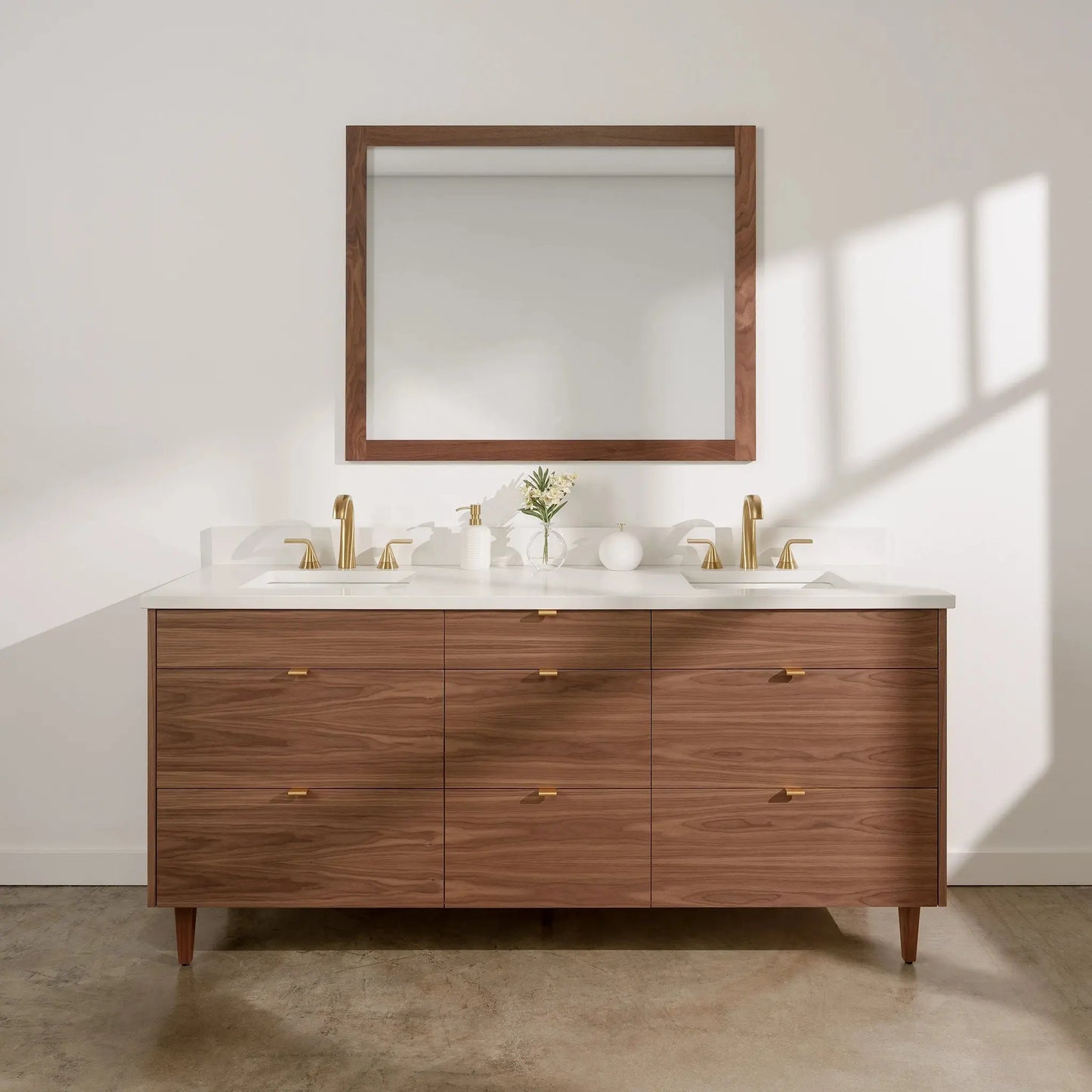Make sure the rough-in plumbing protrudes from the wall at approximately 17"-20" from the ground. This will allow the p-trap to have enough clearance to fit without too much fiddling around. Plumbing in at 17-20" from the ground will allow the vanity top to be mounted at 34" from the ground. As a point of reference, kitchen countertops are mounted at 36" from the ground. Vanities are often mounted a bit lower than kitchen countertops for ease of use for smaller children. If you choose to mount the vanity higher, adjust the rough-in plumbing accordingly. If you are worried about mounting too high for your children to use, a small step stool can easily slide under the wall mount vanity for use.
How To Install A Wall Mounted Vanity
Step 1. Rough In Plumbing
Step 2. Mark Positions
Measure 34" from the floor up the wall to make a reference point. The reference point will help position the vanity at the proper height when mounting to the vanity to the wall with bolts. Once you make a mark on the wall, use a level to continue the line across the wall. Use a pencil and lightly make a line. Using a pencil will allow you to wipe away any marks after installation.
Step 3. Mock Up Mounting Position
Use blocks of wood or anything stable that is approximately 13" in height. In the following example we used blocks of wood. The wood should elevate the vanity to the final mounting height desired. This will allow you to mark the proper mounting bolt location without struggling to hold the vanity up. This also helps for the final installation.
Step 4. Mark Mounting Bolt Location
Use a pencil to mark the location of the mounting bolts.
Step 5. Drill Pilot Holes
The holes should line up with wall studs or a horizontal support stud built into the wall. Use a stud finder to locate the studs. If a wall mounted vanity is NOT secured to studs, there is a good chance it will fall off the wall. Wall anchors do help, but are no means a good alternative to studs.
Step 6. Install Anchors
In the example we had installed wall anchors as added support. The anchors were dipped in epoxy glue for added strength.
Step 7. Install Mounting Hardware
Use an impact gun or cordless drill to drive the lag bolts into the wall/stud. Remember to use a washer with the lag bolt.
Step 8. Install Decorative Caps
Some vanities have decorative caps to cover the lag bolt heads. It is purely decorative and is not needed by any means.
Step 9. Remove Support Blocks
Remove Installation blocks from under vanity.
Step 10. Pre Assemble Drain
Before the vanity top is attached it is a good idea to install the drain and faucet. This will save you from having to crawl under the vanity once installed.
Step 11. Seal Threads
Use white Teflon tape around the threads of the drain. This is a very important step. If you fail to wrap the drain in Teflon tape the drain will leak. This is the most common place for leaks.
Step 12. Silicone Drain
Apply a liberal bead of plumbers putty or silicone to the bottom lip of the drain before placing into the bowl.
Step 13. Insert Drain
Place drain into sink.
Step 14. Install Drain Nut
Tighten drain nut using a pair of channel lock pliers. Gently snug the nut up to the bottom of the bowl. Don't over tighten. You may have to snug up the nut after a short period of time once the rubber seats itself.
Step 15. Remove Excess Sealant
Remove excess plumbers putty from drain flange. If the putty or silicone does not squeeze out, then remove and apply more silicone or putty.
Step 16. Install Faucet
Install Faucet while the vanity top is upside down. This makes things a lot easier.
Step 17. Ball Valve Consideration
Choose the shut-off valve right for you. Any valve below will work fine for a vanity. The 'push-in' and 'compression' valves are the easiest to install and great for beginners. Both valves will work fine on plastic piping and copper.The 'solder ball valve' is the best, most secure valve, but the hardest to install. Leave the soldering to a plumber or experienced do-it-yourselfer. The 'solder ball valve' only works on copper piping.
Step 18. Install Valve
Install valves to copper or plastic (pex) piping.
Step 19. Prepare Vanity for Countertop
Apply bead of silicone to the perimeter of vanity.
Step 20. Place Countertop
Place vanity top onto the silicone bead. This will secure the top to the vanity.
Step 21. Connect Waterlines
Attach supply lines to shut-off valves. Once water supply line are seated, only turn a half turn more. Don't over tighten. Use ties to secure the braided lines.
Step 22. Attach Tailpeice
Attach tailpiece to drain. Make sure to use rubber washer or Teflon tape on the threads if the tailpiece is chrome or brass.
Step 23. Connect P-Trap
Plumb in ABS P-trap. If the inside of the vanity is visible, a chrome p-trap is needed for aesthetics. Use teflon tape on threads of the p-trap clean out.
Step 24. Connect Drain Plunger
Attach drain plunger. The perforated metal drop-down rod may need to be bent to reach the plunger rod. Use the small spring metal clamp to secure the perforated rod to the plunger rod.
Step 25. Re-Install Drawers
Put drawers and doors back into the vanity. Vanity installation is complete.

